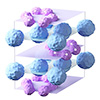| May 15, 2025 |
New experiment deciphers an important intermediate step towards a new phase of matter.
(Nanowerk News) Usually, hydrogen is a colourless gas. Under ultra-high pressure, however, this simplest of all elements should turn into an electrically conducting solid. For decades, this metallic hydrogen has been one of the most important goals in high-pressure research, but conclusive proof of its existence has been elusive. With the assistance of experts at DESY’s X-ray source PETRA III in Hamburg, Chinese researchers have now taken a major step towards this goal. At a pressure of more than two million atmospheres, they observed for the first time the structure of a high pressure phase of hydrogen which can be regarded as a precursor of metallic hydrogen. Additional measurements were carried out at X-ray sources in Chicago and in Lund, Sweden.
|
|
The team is reporting its findings in the journal Nature (“Ultrahigh Pressure Crystallographic Passage Toward Metallic Hydrogen”).
|
 |
| Representative hydrogen structure from the molecular dynamics simulation showing the atomic arrangement in a newly identified phase under simulated conditions. Blue spheres represent freely rotating hydrogen molecules. The H₂ trimer units, i.e. molecular structures consisting of three hydrogen molecules (H₂) that form a honeycomb-like pattern, are shown in purple. (Visualisation: HPSTAR)
|
|
Metallic hydrogen was predicted on theoretical grounds as long ago as in 1935. Since then, scientists around the world have been trying to achieve this exotic state in an experimental setting. It could be of enormous significance: metallic hydrogen is expected to be a superconductor at room temperature, meaning that it should conduct electricity without any losses. It is also being considered as a high-density means of storing energy and as an efficient propellant for space travel.
|
|
“There is already some evidence that molecular hydrogen becomes metallic at pressures above four million atmospheres,” says lead author Cheng Ji, a physicist at the HPSTAR research centre in Beijing. “But until now, we have lacked experimental evidence that would allow us to determine the crystal structure of hydrogen under such extreme conditions.”
|
|
This is because experiments of this kind are extremely demanding. In principle, scientists have long been able to apply high pressure to hydrogen. They do this by enclosing it between two diamond anvils and squeezing it so hard that the gas turns first into a liquid and then a solid. A narrow X-ray beam is then directed at the sample to reveal the crystal structure of the compressed hydrogen. The characterisation process is called elastic X-ray scattering or X-ray diffraction.
|
|
However, at the extreme pressures required to produce metallic hydrogen, this technology approaches its limits. “At millions of times atmospheric pressure, the samples become tiny – in the range of one micrometre,” explains the DESY physicist Konstantin Glazyrin. “Since hydrogen is the lightest of all elements and only scatters X-rays very weakly, it is extremely difficult to obtain useful measurements.” In addition, the diamonds themselves produce a lot of background noise due to Compton scattering.
|
|
To collect reliable data, the team had to optimise its beamline P02.2 over a period of several years. “We developed a high-precision device that can hold the hydrogen sample with an accuracy of less than one micrometre as it rotates within the X-ray beam,” explains Glazyrin. “And in order to scan the sample precisely, we had to concentrate and shape the X-ray beam produced by PETRA III.” Thanks to this improved set-up, it was possible to capture the extremely weak scattering signals from the hydrogen monocrystals and deduce the crystal structure inside the compressed solid.
|
|
As a result, the experts were able to identify a hydrogen structure at 220 gigapascals, or 2.2 million times atmospheric pressure, which indicates the early stages of polymerisation – in which the hydrogen molecules are rearranged into larger units. They observed reflections in the diffraction patterns that indicate specific changes in the crystal symmetry, which the scientists interpret as a sign of impending metallisation. They also carried out computer simulations of the molecular dynamics. These were used to reconstruct how the electric charges are distributed in the crystal.
|
|
Although the metallic state has not yet been achieved, the experiments are making good headway in terms of understanding the intermediate phases. “We now have a better sense of how the protons behave in the crystal,” says HPSTAR researcher Ho-Kwang Mao. “This gives us hope that the metallic state can actually be achieved – and we now have a fuller understanding of how this may happen.” In future, the team hopes to get even closer to its goal by using sophisticated technology to cool the diamond anvil cell. This should delay the failure of the diamonds, making it possible to achieve even higher pressures than before.
|
|
PETRA IV, the planned successor to PETRA III, could lead to significant advances. The beams produced by the new X-ray source will be up to 200 times more intense and much narrower. “This will allow us to move into even more extreme realms in the future,” says Glazyrin. “Because the higher the pressure, the smaller the sample becomes.” To continue collecting usable data from the sample, the significantly more powerful and narrower X-ray beam from PETRA IV is necessary.
|
|
Should the scientific community eventually prove the existence of metallic hydrogen, this could inspire some exciting applications. “This type of hydrogen may be superconducting at relatively high temperatures, meaning it can conduct electricity without losses,” says Cheng Ji. In view of the enormous pressures involved, it could not be used directly in technical applications. However, it could serve as a kind of prototype for new types of high-temperature superconductors, which would allow more efficient technologies to be developed, for example.
|


